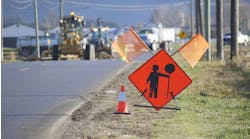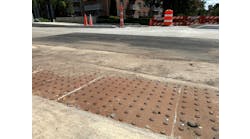Plowable raised pavement markers (RPMs) have been used to augment painted centerline markings for several decades.
The cast iron housing of an RPM protects a highly retroreflective lens. Being inclined and above the pavement, this lens substantially improves lane visibility in both dry and wet nighttime conditions. RPMs are typically installed at 40- or 80-ft spacings and are widely used on rural roads throughout Indiana.
Despite proper installation, snowplows, tractors and heavy trucks can dislodge RPMs, particularly as the roadway ages. A dislodged RPM can become a 6-lb projectile. Safety concerns have caused several states, including Missouri and Nebraska, to remove RPMs from state roadways. Indiana is seeking an alternative centerline treatment to reduce the use of RPMs on state-maintained roads.
In addition to the safety and liability concerns, RPMs are expensive to install and maintain. An individual RPM costs about $10. However, installation requires two parallel cuts be made into the pavement near the joint into which the RPM is epoxied. During repaving operations all RPMs must be removed prior to milling and new pavement placement. Routine replacement of the lenses is recommended, and while the housings are designed to match the life span of the pavement, research suggests many require replacement within five years.
Although plowing operations are suspected to be the primary cause of RPM failure, other mechanisms also damage RPMs.
RPM dislodgement creates potholes that increase both the roughness and the dynamic loading of the pavement, and in some cases removes a portion of the nearby asphalt. Water infiltrates the pothole, compromising the integrity of the sub-base and decreasing the overall life of the pavement. Multiple freeze-thaw cycles in cold-weather regions make this especially problematic.
Indiana is evaluating painted centerline rumble strips (“rumble stripes”) as an alternative to RPMs. Much like RPMs, centerline rumble strips are a centerline treatment being adopted by many states on rural roads. When painted, the rumble strips provide an inclined surface much like that of an RPM lens. Although a single painted rumble is likely not as retroreflective as an RPM lens, the INDOT specification of alternating 1-ft and 2-ft spacing provides on average one painted rumble every 18 in. Compared to the 40- or 80-ft spacing of RPMs, this is a very dense collection of inclined retroreflective surfaces. In addition to improving nighttime visibility, the centerline rumble stripes alert drivers deviating from the marked lane. The auditory and vibratory warnings provided by rumble stripes have already proved effective in reducing across-the-centerline lane departures and head-on crashes.
Hall monitor
To evaluate the performance of rumble stripes, a test corridor was established on S.R. 28 between I-65 and Frankfort, Ind. (MM 52-54) The 2-mile corridor was divided into two sections: Section 1 painted with standard INDOT glass beads (MM 52-53) and Section 2 painted with a combination of INDOT glass beads and 3M wet retroreflective elements (MM 53-54).
In fall 2010 the INDOT paint crew painted the standard painted line and rumble stripe in parallel along the test corridor. This section of S.R. 28 is a four-lane divided highway, allowing for painting of the parallel lines on left and right edge lines of the eastbound lanes. These parallel pavement markings were established for the sole purpose of a side-by-side comparison of the rumble stripe to the standard painted line and do not represent a new standard.
A qualitative evaluation of the corridor under a variety of weather conditions in early 2011 showed that the rumble stripe was outperforming the standard painted line. INDOT performed a comparison of dry day, dry night and wet night marking performance. The rumble stripe remained retroreflective even under continuous wetting.
A post-winter quantitative assessment of the corridor was performed in summer 2011 using a Delta LTL-X retroreflectometer. The data showed that the post-winter retroreflectivity of the rumble stripes surpassed that of the standard painted line.
Yellow is a go
The minimum retroreflectivity threshold standards proposed to the FHWA in 1999 are used as a reference for the S.R. 28 retroreflectivity results for both Section 1 and Section 2. In all cases the rumble stripe outperformed the standard painted line. The results show that the elements significantly increased the retroreflectivity of the rumble stripe, particularly under continuously wetted conditions.
Since an alternative centerline treatment is being sought, the values for yellow marking are of particular interest. Retroreflectivity of the yellow line and rumble stripe were taken with and against the direction of application. As expected the retroreflectivity in the direction of application proved higher in all cases. However, under wet conditions the elements proved much less directionally sensitive than the glass beads.
The S.R. 28 evaluation suggested that rumble stripes may be a suitable alternative to RPMs. Improved retroreflectivity over the standard painted line along with the vibratory and auditory warnings of lane departure support the use of centerline rumble stripes. Additionally it was determined that the rumble stripe improved the retroreflective durability of the pavement marking. The milled rumble protects the paint within and may allow for painting on a biennial (rather than annual) basis. This is particularly important when considering the use of more expensive markings, such as the elements tested in this study. Using the highly retroreflective and less directionally sensitive elements may be desired along corridors with challenging geometries or histories of high crash rates, and painting in only one direction could decrease painting costs.
Taking it further
Further research is being conducted on constructed centerline rumble stripes on Indiana S.R. 38 and 120. Both roads were resurfaced with milled rumble stripes during the 2011 construction season. Joint sealant and fog seal were used to reduce the opportunity for water to penetrate the pavement. The milling operation itself costs less than 30¢ per centerline-foot.
The post-winter retroreflective performance of S.R. 38 and S.R. 120 will be evaluated. Additionally, the S.R. 28 test corridor was not repainted in 2011, providing an opportunity to evaluate the effects of two winter seasons on the standard painted line and rumble stripes.
Acknowledgements
The authors would like to thank Stephen Remias, Alexander Hainen, Gannon Grimmer and Alexander Davis of Purdue University along with Paul Michael and Randy Morris of INDOT for their ongoing assistance with this study. TM&E
Mitkey was a graduate research assistant at Purdue University. He recently passed away. Brennan is a senior research scientist at Purdue


